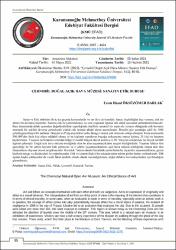| dc.contributor.author | Öksüzömer Barlak, Ecem Hazal | en_US |
| dc.date.accessioned | 2023-01-19T03:03:09Z | |
| dc.date.available | 2023-01-19T03:03:09Z | |
| dc.date.issued | 2021-06-15 | |
| dc.identifier.citation | Öksüzömer Barlak, E. H. (2021). Çernobil doğal açık hava müzesi: sanatın etik duruşu. Karamanoğlu Mehmetbey Üniversitesi Edebiyat Fakültesi Dergisi, 4(1), 84-91. doi:10.47948/efad.874900 | en_US |
| dc.identifier.issn | 2667-4424 | en_US |
| dc.identifier.uri | https://hdl.handle.net/11729/5255 | |
| dc.identifier.uri | http://dx.doi.org/10.47948/efad.874900 | |
| dc.description.abstract | Sanat ve Etik birbirleri ile iç içe geçmiş kavramlardır ve her ikisi de özneldir. Sanat, özgünlüğün dışa vurumu, etik ise ahlaki bir davranış biçimidir. Sanatın etik ile yorumlanması ise onu oluşturan öğenin etik ahlak açısından anlamlandırılmasıdır. Bazı durumlarda ahlak açısından değerlendirilme yapıldığında özellikle sanatsal bir yapıt söz konusu olduğunda etik kavramı otomatik bir şekilde devreye girmektedir çünkü etik özünde ahlaki duruş taşımaktadır. İhmalin göz yumduğu şekli ile 1986 yılında gerçekleşen bir patlama Ukrayna’da Pripyat şehrinin tarihe damga vurarak yok olmasına sebep olmuştur. Kaza sonrasında 500.000’den fazla kişi olaya müdahil olmuş ve bu kişilerin neredeyse birçoğu radyasyona maruz kalmış, 31 kişi ise hayatını kaybetmiştir. Yaşanan bu felaketin ardından bölge Çernobil bölgesi olarak anılmış ve 20. Yüzyılın ortalarında ise birçok turistin ilgisini çekmiştir. Doğal açık hava müzesi niteliğinde olan bu alan yaşanmışlıkların sergisi niteliğindedir. Yaşanan felaket tüm gerçekliği ile bir şehrin hayalet hale gelmesini ve o şehrin yaşanmışlıklarının açık hava müzesi niteliğinde insana dair tüm oluşumlarını duyusal olarak sergilemesidir. Karanlık Turizm olarak literatürde yerini bulan bu ziyaretler yaşanmışlıkların, gezen kişilerin duygu ve düşünceleri ile yoğrulmasıdır. Etik ve sanatın ilişkisi bu noktada tekrar tekrar gözler önüne serilmektedir. Etik açıdan başka yaklaşımlar da vardır fakat tanıklık etmek olarak incelediğimizde, etiğin ahlakın mevcudiyetinden sıyrılmadığını görmekteyiz. | en_US |
| dc.description.abstract | Art and Ethics are concepts intertwined with each other and both are subjective. Art is an expression of originality and ethics is a moral behavior. The interpretation of art from an ethics point of view is the meaning of the element that constitutes it in terms of ethical morality. In some cases, when an evaluation is made in terms of morality, especially when an artistic work is in question, the concept of ethics comes into play automatically because ethics has a moral stance in essence. An incident of negligence in 1986 in the city of Pripyat, Ukraine led to an explosion that destroyed the city. Due to this accident, 31 people were killed and more than 500, 000 were exposed to radiation. This region is known today as the Chernobyl Zone and has attracted the attention of tourists since the middle of the 20th century. This area, which is a natural open air museum, is an exhibition of experiences. Visitors can have a full sensory experience of the disaster by walking through the ghost of the city that remains. These visits, which find their place in the literature as Dark Tourism, are the blending of these experiences with the feelings and thoughts of the people traveling. The relationship between ethics and art is revealed at this point. There are other approaches in terms of ethics but when we examine it as testimony, we see that ethics does not escape the existence of morality. | en_US |
| dc.language.iso | tr | en_US |
| dc.publisher | Karamanoğlu Mehmetbey Üniversitesi | en_US |
| dc.relation.ispartof | Karamanoğlu Mehmetbey Üniversitesi Edebiyat Fakültesi Dergisi | en_US |
| dc.rights | info:eu-repo/semantics/openAccess | en_US |
| dc.subject | Sanat | en_US |
| dc.subject | Etik | en_US |
| dc.subject | Ahlak | en_US |
| dc.subject | Çernobil | en_US |
| dc.subject | Karanlık turizm | en_US |
| dc.subject | Art | en_US |
| dc.subject | Ethics | en_US |
| dc.subject | Morals | en_US |
| dc.subject | Chernobyl | en_US |
| dc.subject | Thanaturism | en_US |
| dc.title | Çernobil doğal açık hava müzesi: sanatın etik duruşu | en_US |
| dc.title.alternative | The Chernobyl natural open air museum: an ethical stance of art | en_US |
| dc.type | Article | en_US |
| dc.description.version | Publisher's Version | en_US |
| dc.department | Işık Üniversitesi, Sosyal Bilimler Enstitüsü, Sanat Bilimi Doktora Programı | en_US |
| dc.department | Işık University, Institute of Social Sciences, Art Science Doctorate Program | en_US |
| dc.authorid | 0000-0002-5615-2279 | |
| dc.authorid | 0000-0002-5615-2279 | en_US |
| dc.identifier.volume | 4 | |
| dc.identifier.issue | 1 | |
| dc.identifier.startpage | 84 | |
| dc.identifier.endpage | 91 | |
| dc.peerreviewed | Yes | en_US |
| dc.publicationstatus | Published | en_US |
| dc.relation.publicationcategory | Makale - Ulusal Hakemli Dergi - İdari Personel ve Öğrenci | en_US |
| dc.institutionauthor | Öksüzömer Barlak, Ecem Hazal | en_US |


















